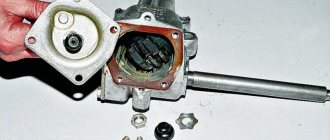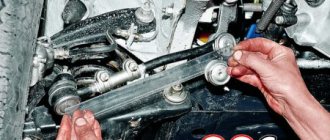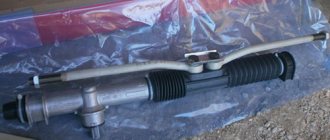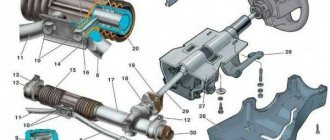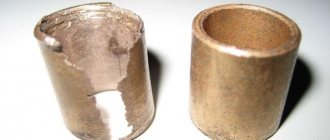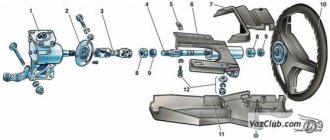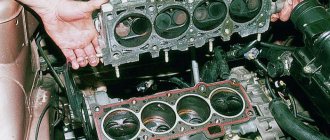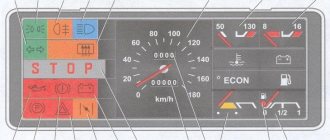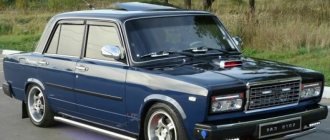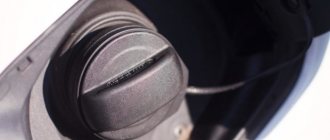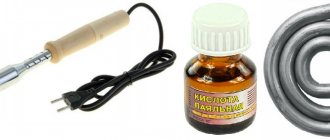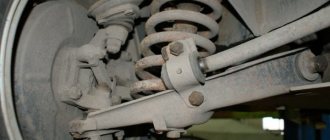Replacing the steering column or gearbox
Hello again. Thanks everyone for the advice on the steering column.
After reading the information about the repair, I realized that it was not worth the money.
The best option was to purchase a used column in good condition, because... Knowing about the current quality, many will understand me. During the survey, it turned out that Private838
has a normal steering column, which is what I wanted to take.
My grandfather also found out about the problem, and it turned out that a friend of his from the garage had a five-piece gearbox in superb condition. Actually, I got it for myself for seven. For installation I used a steering wheel end puller. The most stressful thing was to unscrew the 3 bolts that secure the gearbox to the body, which was very inconvenient for me personally. In the process, we had to additionally remove the adsorber, the control center, unscrew the locker, remove the wheel and unscrew the cardan from the column shaft
.
the puller is in use, the steering rods are in excellent condition
this is where the oil was flowing, but it was still normal in the gearbox
Oil was also leaking through the side cover.
After comparing the old and new ones, it turned out that my gearbox was a little tight to spin behind the bipod, but with the new one everything was fine. The adjusting screw in my column was recessed flush. The new one stuck out about 4 mm.
old and new
you can see how much the regs are screwed in. screws
place where the cardan is disconnected from the shaft
Then I put everything back in place. In order not to calculate the position of the steering wheel, which was not deployed correctly, I simply removed it and put it in place. I left the old oil in the column because it was yellow. I just topped up a few cubes of Lukoil mineral water.
everything is collected
syringe and oil
Result. After adjusting the steering wheel and driving around, I realized that the controls had changed beyond recognition. If earlier on bumps the steering wheel sat gently in your hands, now it began to be knocked out. On a flat road he stands straight and does not move. Previously, he was wobbling in all directions. In general, I'm pleased.
Among the tips for improving the service life of the speaker, I can say:
1. It does not need to be tightened when adjusting; there should not be much play. 2. Do not turn the steering wheel in a place where it is difficult to turn (asphalt and other surfaces where there is more friction).
Good luck to everyone, may the quality of spare parts be with you!
A knocking sound is heard when turning - possible causes
Steering rack. The first thing people tend to do wrong is the steering rack. If you hear a knock when turning the steering wheel in place, then it is likely, although not a fact, that the rack needs repair or even replacement. I have already talked about steering rack malfunctions; if you suspect that it may be involved in your problem, I recommend reading this article. A knock when turning the steering wheel in this case may be due to the fact that there is play or wear in the rack. Over time, problems can occur with the worm or worm gear, as well as the rack and pinion. If your suspicions about the rack are confirmed, then you will have to restore the steering rack or completely replace it. Read how to replace the steering rack here.
Installation and repair of the steering column on a VAZ 2107
One of the elements of the VAZ 2107 car, which received a number of improvements in this model compared to the previous ones, is the steering column.
How is its device different? In the VAZ 2107, the steering column shaft consists of two parts connected by a cross. Thanks to this design, driver safety is significantly increased, since in the event of a collision the shaft simply bends at the hinge joint and does not cause serious harm to the person. Also, the shaft in the VAZ 2107 has bearings, so turning the steering wheel requires much less effort. The steering column of the VAZ 2107 consists of a shaft with an articulated joint and a gearbox with a worm gear. Column repair is a very rare occurrence. If you ensure timely maintenance of this unit, it may never be needed. Steering column maintenance work includes lubricating the steering shaft joint, tightening the steering wheel nut, changing the oil and adjusting the gearbox. Let's look at possible problems associated with the steering column and methods for eliminating them.
Creak in the column
Typically, creaking appears due to insufficient lubrication of shaft parts - bearings or crosspieces. It can be treated by lubrication, does not cause any particular problems, and no repairs are required.
How to replace the steering column bushing on a Toyota
To eliminate knocking in the control column on a Toyota, you can replace the bushing. The replacement process itself will not cause any particular problems. First, remove the steering column panel - it's easy. To do this, the bolts are unscrewed and then the shield is simply removed from the retaining latches. Then part of the air duct is dismantled.
Now that you have access to the steering column, you need to unscrew everything that might interfere with its removal. When all that remains is to remove the column, you should mark with a marker the place and position in which it will need to be installed after repair. It is necessary to remove the column carefully, because it has a certain weight. It is recommended to lay the mechanism on something soft - it must be placed with the control wheel down.
Now you need to start dismantling the bushing, but doing this manually will not work. You need to screw two or three screws into it, which will serve as a support during the removal process. When the screws are screwed in, but not completely, cover the control wheel with something soft, rest your feet on it and pull the screws with pliers. After applying force, the bushing will come out.
How to adjust the steering column of a VAZ.
After dismantling, the shaft must be carefully cleaned and treated with good lubricant. The new bushing is carefully installed in its place. And after that the knocking often goes away. But if the driver still hears it, it means the crosspiece needs to be replaced.
STEERING WHEEL PLAY
The appearance of steering play can be caused by two reasons. First, the nut securing the steering wheel to the shaft is loosened. If the nut is not tightened promptly, the splines on the handlebar and shaft will become damaged over time and one of these parts may need to be replaced. The second reason may be wear of the worm gear. To eliminate this malfunction, a special device is provided - an adjusting bolt with a lock nut.
In order to adjust the worm gear, the nut is released, the screw is turned using a screwdriver until the backlash is eliminated, after which the nut is tightened to prevent spontaneous unscrewing. If it is impossible to eliminate the backlash by adjustment, it means that the gearbox needs to be repaired and the worm pair replaced.
To prevent premature wear of gearbox parts, periodic monitoring of the oil level and its replacement is recommended. Level control is carried out as follows:
- Using a 8 key, unscrew the filler plug;
- Use a screwdriver or other object to check the oil level. It should be level with the bottom edge of the filler hole.
- If necessary, add oil using a special supercharger until it begins to flow out of the hole.
To change the oil, unscrew the screws securing the gearbox cover, having previously placed a container under it to collect used oil. Since complete removal of the cap is not required, it is moved to the side and the oil is drained. This operation is best performed on a hot engine. Warm oil has greater fluidity and drains faster. After all the oil has drained out, the cap is screwed into place and new oil is poured into the gearbox using the method described above.
If you hear a noticeable knocking noise when you move the steering wheel left to right: diagnosis
Probable Causes
If an audible knocking sound in the front suspension when turning the steering wheel indicates wear in its constituent parts, then an extraneous clicking sound when the steering wheel rocks requires inspection of other structural elements. As a rule, the problem lies in the vehicle control system.
Statistics show that there is something to knock in the “steering wheel”. Any pairing may come under suspicion:
- Gap in the fit between the steering tip and the strut.
- Excessive play in the steering rack.
- There is a problem with the steering shaft driveshaft.
- Free movement of the steering wheel on the shaft.
- Gap in steering rod joints.
These parts are present in the design of any car. Knowing the location of all the landings, it remains to identify the defective pair.
For your information. Some old foreign cars have a folding steering column assembly, which breaks under the influence of a critical load that occurs during an accident. He can knock too.
How to identify knocking: expert methods
The classic approach to identifying a faulty unit will be explained in any garage. Its essence is trivial: just ask the assistant to shake the steering wheel and at this time put his hand on the mentioned connections.
Steering rack
However, in some situations this technology loses its relevance. In particular, it will not be possible to identify a defect in the mechanism using this method. To identify a problem in the gear-rack engagement, it is necessary to carry out the following experiment:
- If there is power steering (hydraulic booster): a knocking sound appears when the steering wheel is rotated on a car with the engine turned off, but when the engine is running, there is no knocking at the place.
- There is no power steering: drive along a road section with a changeable direction - when you swing the steering wheel left to right, a knock is heard, but when turning, the rack does not knock due to the small wear of the working surfaces of the gearing in the extreme positions.
For your information. It is not recommended to tighten a worn rack. One of the owners of Hyundai Solaris performed this procedure and after 10,000-12,000 km the steering wheel began to bite. An autopsy showed that the mechanism was beyond repair.
Emergency system
It is also possible to determine experimentally whether the steering column folding assembly is the cause of the knocking. It is enough to swing the “steering wheel” to the sides, while simultaneously pressing it to the bottom. The sound disappeared - the problem is in the emergency system.
REMOVAL OF THE GEARBOX
The design of the gearbox does not allow it to be repaired without removing it from the vehicle. In order to remove it, you must:
- Disconnect the tie rod ends from the gearbox. First, they are uncoiled, then the nuts are unscrewed with a 22 wrench and the tips are pressed out using a special puller.
- Unscrew the clamp securing the steering shaft to the gearbox.
- Remove the three bolts that secure the gearbox to the car body.
The gearbox design should not cause any particular difficulties when repairing it. You just have to take into account that the worn elements, called the worm pair, are both replaced at the same time. After this, adjustments must be made.
Front suspension repair
The cost of the parts themselves when eliminating the described reasons is most often small, but the price of replacing them in car services sometimes causes bewilderment. In such cases, it is better to repair the suspension yourself. This requires special devices and tools.
To remove the tips and ball joints of the steering wheel, pullers are needed that, during dismantling, preserve the integrity of these parts.
Silent blocks are replaced using a long threaded rod or bolt with a corresponding nut and a set of bushings and washers. The bushings should rest on the lever cage, and the washer should match the diameter of the rubber seal. Tightening the nut squeezes the silent blocks out of the lever, and then presses a new one in its place.
Steering mechanism VAZ 2107
VAZ cars, which are classic models, are distinguished by pleasant reliability. This also applies to the steering mechanism.
It is quite complex, but its design allows you to maneuver and ensure reliable vehicle control even in the most difficult road conditions.
The modernization process led to the installation of a composite shaft and a safety column. Due to the size of the steering wheel, the driver makes the necessary maneuvers without any problems. From lock to lock, it takes 3.5 turns to turn the steering wheel completely. The force from the steering column is transmitted to the drive via a composite shaft.
The current steering mechanism on the VAZ 2107, a product of the Volga Automobile Company, is quite informative and does not allow the driver to get tired during long trips. There are certain difficulties when turning in a parking lot, but as soon as the car begins to move, the resistance weakens and turning the steering wheel becomes easier.
There is one more nuance - when the steering mechanism is working properly, there is a slight play. But its limit value complies with the traffic rules. This is due to the fact that there are steering rods on the VAZ 2107 and an impressive number of elements in the gearbox.
In general, the steering of the 7 can be considered reliable.
Sound criteria
There are plenty of reasons why the engine knocks.
Some knocking noises only indicate minor problems that can be easily diagnosed and corrected during the next inspection. But there are a number of sounds that very clearly indicate that there are serious problems with the internal combustion engine that require immediate intervention in order to avoid the occurrence of many unpleasant situations, such as, for example, a major engine overhaul. The occurrence of any sound occurs due to the fact that one element of the internal combustion engine hits another, and each of the impacts can have its own individual sound coloring, intensity, duration and frequency.
A sound of medium volume and intensity indicates a more serious problem. In this case, the first thing you need to do is go to the nearest car service center to avoid serious engine damage.
If the sound marker has a clear, loud sound color, then the car owner urgently needs to turn off the engine and call a tow truck. When moving independently, the motor may knock.
Mechanism design
To repair the steering column on a VAZ 2107, you first need to understand its structure, as well as the principle of operation.
The seven is in many ways similar to the “penny”. Therefore, the device and design received minor changes. The structure includes:
- A mechanism that transmits the driver’s force to the executive components;
- A steering drive that turns at an angle specified by the driver.
In turn, the steering mechanism consists of:
- Composite shaft with cardan transmission;
- Steering wheel (steering column together with a steering wheel with a diameter of 520 mm);
- Worm gearbox of the VAZ 2107 steering mechanism.
The control system has the following components:
- Bipod;
- Pendulum arm;
- Swivel arms;
- Steering rods for VAZ 2107 (one middle, two side).
The outer rods include two parts, which allows you to change their size by adjusting the toe angle.
Tie rod/end set for VAZ 2107
The operating principle of the steering mechanism looks like this:
- The driver begins to rotate the steering wheel, the wheel size of which ensures that this task can be performed quite simply;
- By means of a composite shaft, a worm gear is activated, which reduces the speed;
- The steering mechanism is lubricated with special oil (TAD 17) poured into the gearbox;
- The worm gears rotate, which causes the double ridge roller to move;
- This, in turn, causes the secondary shaft to rotate;
- The tray mounted on the secondary shaft makes a turn and pulls the rod system behind it;
- These components influence the levers that synchronously rotate the wheels to the required angle specified by the driver.
Parts of the steering gear housing: 1 - housing; 2 - bipod; 3 — lower crankcase cover; 4 — adjusting shims; 5 — outer ring of the worm shaft bearing; 6 — separator with balls; 7 — bipod shaft; 8 - adjusting screw; 9 — adjusting plate; 10 — lock washer; 11 - worm shaft; 12 — upper crankcase cover; 13 - sealing gasket; 14 — bipod shaft sleeve; 15 — worm shaft seal; 16 — bipod shaft seal.
Steering column parts: 1 — steering gear housing; 2 - shaft seal; 3 - intermediate shaft; 4 - upper shaft; 5 — fixing plate of the front part of the bracket; 6 — bracket for fastening the steering shaft; 7 - upper part of the facing casing; 8 — bearing sleeve; 9 — bearing; 10 — steering wheel; 11 — lower part of the facing casing; 12 — bracket fastening parts
Why is there a knocking sound in the engine when the speed increases? »
Why is there a knocking sound in the engine when the speed increases?
Engine knocking when revving up
, may have its own reasons for different types of power units. This is due to the technological features of such motors. When conducting diagnostics, this factor should be taken into account.
If you have a chain-driven engine, then the reason for the increase in engine sound when you press the gas pedal may be the chain. When pulled out, it begins to rumble against the body of the block. This manifests itself primarily when adding gas; the sound level from the engine increases significantly. The engine also starts to run much louder in all modes. Check the chain tension and tighten it if necessary.
Find out which part of the engine the knock is coming from. Camshaft wear often appears at high speeds. In this case, the sound will be heard from the top of the motor. In this case, the intensity of the sound will directly depend on the number of revolutions. The greater the load on the motor, the easier it is to notice the source of the sound. When exactly this sound appears, you need to remove the camshaft. Bearings usually fail; replace the failed shaft.
Sometimes, a knock may appear for reasons only indirectly related to the engine. On domestic cars and budget foreign cars, a similar knocking noise can be caused by problems with the pump. If the bearing fails, it may start knocking. It is located close to the engine, so many people confuse any sounds it makes with engine knocking. Moreover, the characteristic feature here is precisely the appearance of knocking sounds and an increase in their intensity depending on the number of revolutions. Often, even experienced mechanics cannot determine by ear whether it is the camshaft or the pump that is knocking. Such a malfunction can only be detected by removing the water pump. When you try to twist the removed part, you will hear a slight tapping sound. In this case, replace it completely or partially.
Sometimes knocking can be observed at both low and high speeds. The cause is most often a lack of lubrication. Check the engine oil level. If it is clearly not enough, then most likely this is the problem. Add lubricant. Separately, you should consider the option of low-quality oil. There are plenty of counterfeit products on the market, so anyone can buy them.
This lubricant does not form a protective film, which causes knocking of parts when the engine is running. At low speeds this is almost unnoticeable, but at high speeds the knocking will be quite serious. If engine knocking appears shortly after changing the oil, then it makes sense to check the quality of the new lubricant. Sometimes the sound appears as a result of flushing the engine when changing the oil. In this case, the reason for the knocking is the removal of coke deposits from the parts. This is not a terrible phenomenon and will pass after some time.
In principle, everything that has been said about gasoline units can be attributed to diesel engines. But, there is another problem that is typical for this type of engine. One of the important components of a diesel engine is the fuel system. If the combustible mixture supplied to the cylinders is unbalanced, increased engine noise may be observed. If there is a problem with knocking or increased noise while the engine is running, then it makes sense to check and adjust the fuel supply.
Knocks in the engine can be caused by a variety of reasons. Experienced mechanics know a large number of different examples of the appearance of noise, even funny ones. For example, when the knocking of the crankshaft was mistaken for the tapping of the unscrewed protection of the pan. In order not to be frightened by such trifles, let's look at how to find the cause of the knocking.
First, determine when the sound occurs. First of all, listen at what stage the noise appears. Usually there are 3 scenarios:
- Knocks at idle;
The sound is heard all the time the engine is running;
Increasing knocking or noise at high speeds.
Repair and maintenance
Over the years of operation it has been proven that the steering on VAZ 2107 vehicles has impressive reliability. However, this does not take away the fact that the machine requires periodic inspection and repair.
- When performing maintenance, it is important to check for increased play as well as increased wear on the ball joints. To do this, you need to turn the steering wheel from one side to the other. If the wheels do not respond when the steering wheel is turned 5 degrees from its original position, this indicates severe wear. Here you will need to repair the steering column on a VAZ 2107.
- To avoid the need for urgent and rather expensive repairs of the steering gear on a VAZ 2107, it is necessary to change the oil in the worm gear housing. This is done at intervals of 60 thousand kilometers. Leaks may occur through the seals, so they are carefully checked 2-3 times a year. This is one of the weak points of the system.
- The swing arm should be inspected by slowly rotating the steering wheel from side to side. If the parts move in a vertical plane, then surgical intervention is required.
If any malfunctions are detected, the breakdowns should be repaired immediately.
To do this, the drive and steering mechanism are dismantled completely or partially. Everything depends directly on the nature of the breakdown.
Check which parts have defects and what has failed. Inspection is required for each component of the mechanism. If parts are worn out, there is no point in trying to repair them. There is only one way out - a complete replacement of worn-out components of the steering system on a car from a Volga company.
If problems arise with the steering, it is advisable to contact a professional service station.
Photo of the VAZ 2107 steering gearbox
You can replace the gearbox yourself, but the process is complicated and requires at least minimal experience and skills.
The VAZ "Seven" is a true classic of the domestic automotive industry. Unlike modern LADAs, they are more reliable and durable, which is proven by the huge presence of these cars on our roads.
Of course, the VAZ 2107 has long been outdated, it does not have a hydraulic booster, and you have to apply sufficient force to turn and maneuver. But for connoisseurs this is not a problem.
What is engine knocking?
The appearance of engine knocking in most cases indicates that in the area of mating of certain parts there has been a critical increase in the gaps between the elements. If the engine lubrication and cooling systems are functioning normally, then noise and knocking begin to appear at clearances that, on average, are double or more times the permissible parameters. The strength of the knock directly depends on how much the gap has increased. It turns out that knocking in the engine is the impact of parts against each other, the load at the point of contact increases significantly. In this case, wear of parts occurs much faster.
The rate at which further wear increases will depend on the size of the gap, materials of manufacture, load, lubrication efficiency and a number of other factors. For this reason, some components can go through tens of thousands of kilometers with a knock without serious consequences (the timing belt), while others (CVM and CPG) can fail after just a few kilometers. In some cases, the engine may knock even if the clearances are normal and there is no serious wear on the parts. This knocking noise can be caused by:
- detonation and heavy loads on the internal combustion engine;
- distortions of parts inside the engine;
- jamming of individual elements;
- loss of protective and other properties by motor oil;
How much does a steering column cost for a VAZ 2107
The cost of a VAZ 2107 steering column in Russia varies from 1,450 to 4,449 rubles .
The steering column of the VAZ 2101-2107 family is a mechanism for transmitting natural force from the steering wheel to the wheels through rotational actions. Inside the column, the steering shaft contacts another gear, forming a worm pair, which, in turn, transmits force to the steering linkage. Inside the case, which is made of silumin (does not oxidize when in contact with liquids), there is an oil bath. The efficiency of the mechanism is also achieved thanks to the following components (included in the repair kit):
- Adjustment screw.
- Worm bearing.
- Stuffing box.
- Bipod shaft bushing.
- Bipod shaft seal.
- Adjusting shim.
- Bipod shaft roller thrust washer.
It is best to buy an original steering column, which differs from analogues not only in the cost of 1,100-1,430 rubles. , but also design features. We are talking about fastenings to the body. These are tear-off fasteners or shear bolts, which, in the event of an accident, will protect the driver from injury from the steering column. In addition, the original speakers 21050-3400010-00 for Lada 2101-07 and a dry weight of 5 kg have reinforced threads on the shaft, which do not deform during shocks from the suspension and other operational features.
How to remove the bipod of the VAZ steering column using a hammer drill.
In general, it is advisable not to unscrew this nut, since then you will have to knock the column off the splines, which is not a very pleasant task. It is more convenient to simply disconnect the column along with the steering tips. But since I completely disassembled the car, this was not important for me. Anyone who removed a bipod this way, please like and comment!!! An interesting way to remove the steering column bipod using a hammer drill. The VAZ steering gear housing was broken when removing the steering bipod. Replacing the steering column bipod roller.
What affects the cost?
The cost of a steering column is influenced by the following factors:
- Manufacturer.
- Country of origin (Eurasian compliance standards).
- Type of component.
- Type of equipment.
- State.
- Brand.
- Type of spare part.
- Type of modification (without hydraulic booster).
- Model.
- Serial compatibility.
In addition to such key parameters, the cost is also affected by the type of packaging and internal placement of the product. Original steering columns, which have a clear centering position with a noticeable effort to overcome it, regardless of the direction of rotation, are always equipped with an output shaft mounting bipod. The latter prevents its rotation and axial displacements in the bearing and oil seal. Also, the original AvtoVAZ packaging is different:
- Complete with technical data sheet and warranty card (separate sealed bag).
- Security seal with laser engraving on the top and bottom.
- Since February 2016, compliance with Eurasian standards is indicated on the side of the box, instead of specifications.
Also included in the price is the oil used to fill the steering column. During transportation, the adjusting bolt and gasket are in a free state, which requires compliance with the orientation of the product in space.
Types and prices
The original steering column for passenger cars of the VAZ 2101-07 family has catalog number 21050-3400010-00 . Its cost varies from 2,172 to 4,449 rubles . In order for the classification of goods to be as complete as possible on the part of the buyer, the price can be divided by series and compatibility. The latter looks like this:
- VAZ 2102, 1973-1985 – 2,797-4,449 rubles.
- VAZ 2103, 1972-1984 – 2,797-4,449 rubles.
- VAZ 2106, 1975-2006 – 2,430-4,300 rubles.
- VAZ 2101, 1970-1988 – 2,172-4,301 rubles.
- VAZ 2106, 1975-2005 – 2,430-4,250 rubles.
- VAZ 2104, 1984 – 3,934 rubles.
- VAZ 2105, 1981 – 4,012 rubles.
- VAZ 2107, 1982-2012 – 2,640-4,449 rubles.
- VAZ Niva (2121), 1976 – 2,970-4,440 rubles.
- VAZ 2121, 1994-2006 – 2,970-4,440 rubles.
- VAZ 21213, 2001-2006 – 2,700-4,449 rubles.
If we take into account the gradation by series, the pricing policy is as follows:
- 2101, 1970-1988 – 1,450-4,449 rubles.
- 2106, 1975-2005 – 2,797-4,449 rubles.
- 2107, 1982-2012 – 2,400-4,449 rubles.
Prices are given for original AvtoVAZ products and their copies in similar packaging, configuration, as well as manufacturer’s warranty. Each of the items contains oil in the crankcase of the lubrication system.
